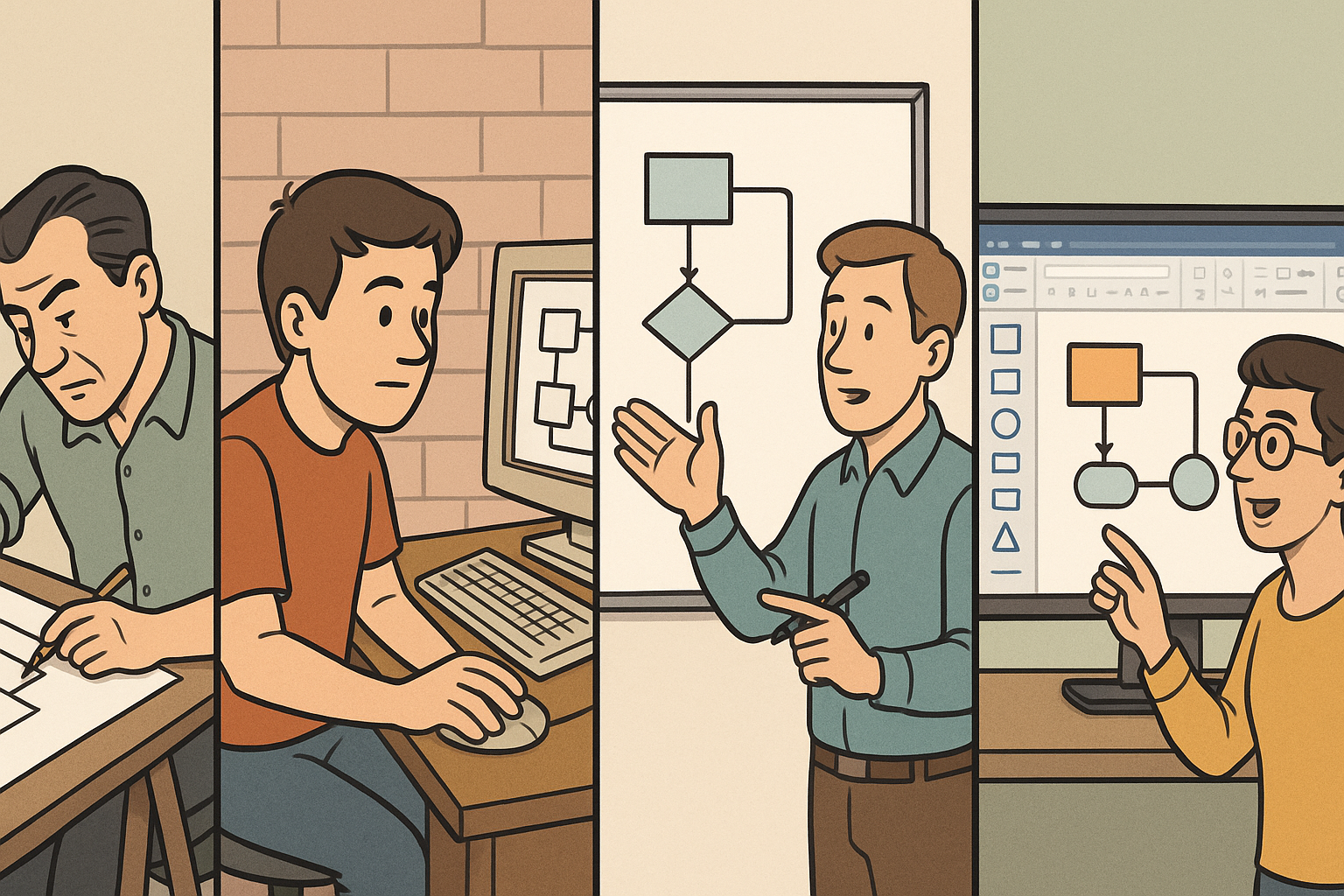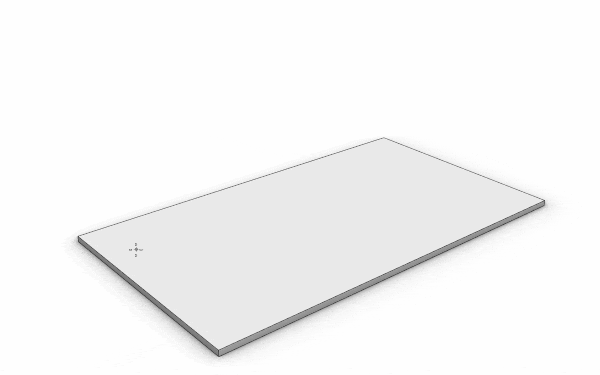Your Cart is Empty
Customer Testimonials
-
"Great customer service. The folks at Novedge were super helpful in navigating a somewhat complicated order including software upgrades and serial numbers in various stages of inactivity. They were friendly and helpful throughout the process.."
Ruben Ruckmark
"Quick & very helpful. We have been using Novedge for years and are very happy with their quick service when we need to make a purchase and excellent support resolving any issues."
Will Woodson
"Scott is the best. He reminds me about subscriptions dates, guides me in the correct direction for updates. He always responds promptly to me. He is literally the reason I continue to work with Novedge and will do so in the future."
Edward Mchugh
"Calvin Lok is “the man”. After my purchase of Sketchup 2021, he called me and provided step-by-step instructions to ease me through difficulties I was having with the setup of my new software."
Mike Borzage
Design Software History: The Evolution of Diagrammatic Design Software: From Manual Drafting to Microsoft Visio's Transformative Impact on Visual Communication and Collaboration
May 22, 2025 7 min read


Background and Context
Historical Evolution of Diagrammatic Design
The evolution of diagrammatic design has been a complex progression driven by a need to better understand and communicate multifaceted information visually. In the early years of design software, professionals and creatives relied on paper-based sketches, rudimentary computer-aided drawing systems, and basic digital interfaces that lacked the advanced functionalities necessary to render highly detailed diagrams. Prior to the advent of tools like Microsoft Visio, pioneering applications attempted to capture the essence of design through limited graphical capabilities, often resulting in inconsistent outputs that did not meet the growing demands of industries such as engineering, architecture, and business process management. During this transformative period, elements such as user interface design, data integration, and collaborative functionality were practically non-existent, making clear visual communication a formidable challenge. This era of design was marked by a reliance on manual drafting techniques and isolated desktop software systems whose interconnectivity was far from seamless. The landscape that emerged in the 1980s and 1990s was one in which practitioners had to rely on a patchwork of different solutions, each with their own strengths and weaknesses, in order to meet the unique demands of various industries.
As design disciplines matured, comprehensive methodologies began to emerge that harnessed the power of technological innovation along with solid theoretical foundations in geometric and algebraic modeling. This development laid the groundwork for a unified approach that eventually led to the creation of purpose-driven applications designed specifically for digital diagrammatic representation. The transformation was influenced by the convergence of several key motivations, including the drive for increased clarity in communication, standardization in encoding complex relationships, and the desire to integrate design tools more seamlessly with business processes. The need for consistent representations such as flowcharts, network diagrams, and structure charts became more important as organizations sought to optimize their internal workflows. To address these challenges, several foundational initiatives were launched which aimed at automating the processes of design rendering and facilitating systematic design documentation. Notable early trends included:
- User-driven innovation that sought to translate manual drafting workflows into digital environments.
- The integration of emerging computer graphics technologies with existing design principles.
- An emphasis on creating standardized symbols and notations to represent complex systems clearly.
The Rise of Microsoft Visio
Introducing a New Paradigm in Diagramming
With the launch of Microsoft Visio, the domain of diagrammatic design experienced a paradigm shift that redefined contemporary design software. Visio was introduced as a part of Microsoft’s expansive suite of productivity applications, immediately distinguishing itself through an intuitive interface and robust feature set that met the growing needs of professionals across various sectors. This innovative tool departed from earlier diagramming software by emphasizing ease of use, dynamic templates, and versatile drawing capabilities. Before Visio, the market was populated by tools that often required an extensive learning curve and delivered limited interoperability with other office applications. Microsoft’s solution was strategically positioned to fill this gap by streamlining the diagram creation process and offering integrated connectivity with widely used products such as Word, Excel, and PowerPoint. The software’s design was built on a foundation that valued both usability and technical precision, creating a tool that could be used equally well to design business process flows, complex network diagrams, and detailed engineering layouts.
One of the most critical breakthroughs that Visio delivered was its comprehensive suite of features which included:
- Templating systems that provided pre-designed frameworks for various diagram types.
- Drag-and-drop interfaces ensuring that users could effortlessly build and modify diagrams.
- Seamless integration with Office products that allowed quick export and embedding of diagrams into other documents.
Innovations, Integration, and Industry Impact
Technological Breakthroughs and Design Integration
The development of Visio was marked by several groundbreaking innovations that fundamentally altered the trajectory of design software and the practices of diagrammatic design. Among its critical technological breakthroughs was the introduction of comprehensive templating systems that empowered users to create complex diagrams by leveraging pre-built frameworks. The software’s drag-and-drop interface was another important innovation, making the process of constructing diagrams intuitive and highly efficient. These features, coupled with its ability to seamlessly integrate with other Microsoft Office products, ensured that Visio could serve as a unifying tool across an organization’s communication ecosystem. In various industries, from engineering and business process management to education, the integration of Visio allowed for greater accuracy in capturing processes and conveying technical information. Some of the essential capabilities that underscored its success included:
- Dynamic linking of diagram elements with real-time data feeds.
- Robust icon libraries that conformed to international standards for technical representation.
- A platform that supported collaboration, allowing multiple users to refine and iterate on diagrams in near real-time.
Beyond its immediate technological features, Visio also played a significant role in transforming the workflow and operational paradigms of many industries. Its introduction catalyzed a shift in how organizations approached the visualization of complex data sets and interconnected processes, ensuring that clarity and adaptability would become cornerstone attributes of modern design software. Professionals could now streamline communication channels, reduce the redundancy of manual revisions, and leverage digital templates to maintain consistency throughout various projects. The software’s extensive integration capabilities also meant that data integrity and design accuracy were elevated across all levels of an organization. Additionally, the growth in its user base led to a broader elevated emphasis on standardization in diagrammatic languages, influencing how industries approached design documentation on a global scale. This digital revolution in diagramming practices not only improved operational efficiency but also established new benchmarks in the wider field of engineering computation and architectural design, thus enriching the legacy of Microsoft Visio as a transformative tool in the annals of design software history.
Conclusion
Reflecting on Visio’s Transformative Legacy
In retrospect, the introduction and evolution of Microsoft Visio heralded a transformative era for visual communication and diagrammatic design. Its launch marked a clear departure from the cumbersome, inconsistent methods previously employed in design, setting in motion a technological revolution that reshaped how professionals create, communicate, and collaborate across disciplines. The standardization of design symbols, integration with other widely used office applications, and the development of an intuitive interface facilitated the adoption of Visio across a plethora of industries, including business process management, engineering, education, and architectural design. Moreover, the software functioned as a catalyst for fostering a culture that continually sought accuracy, readability, and efficiency in digital representations. Guided by a commitment to innovation, Visio has not only redefined diagrammatic practices but also influenced subsequent design tools and software solutions that drive modern workflows. The features it introduced remain embedded in current applications, setting a benchmark that developers and tech companies continue to build upon in today’s rapidly advancing technological landscape.
The enduring legacy of Visio is evident in the manner in which contemporary design and diagramming applications have embraced core principles such as seamless integration, consistent usability, and robust feature sets designed to support an increasingly digital way of working. Users today benefit from visually compelling and functionally enriched experiences that empower them to distill complex systems into easily digestible formats. In our current digital ecosystem, characterized by rapid technological transformations and an ever-growing demand for collaborative tools, the foundational elements introduced by Visio continue to inform the evolution of design software. The development of comprehensive templating systems, coupled with the intuitive drag-and-drop interface, have become standard expectations for modern applications, influencing every facet of design software that followed. In this context, Visio not only set new industry standards in the late 1990s and early 2000s but also laid down a blueprint that continues to inspire current innovations, ensuring that the spirit of innovation and clarity lives on in every new iteration of diagrammatic and design technology.
As we look forward, it is clear that the legacy of Microsoft Visio will remain a cornerstone of design software history and a benchmark for future advancements in diagrammatic design tools. Today’s solutions have built upon its extensive groundwork, further enhancing automated diagram generation, real-time collaborative editing, and data-driven customization capabilities. With this continuous evolution in mind, it is evident that the fusion of technological creativity and user-centric design will remain fundamental in driving innovation in industries worldwide. The impact of Visio underscores an important lesson for developers and industry leaders alike: the transformative power of well-conceived design software lies not only in its current utility but also in its ability to inspire future generations of tools that aim to make the complex simple and the abstract easily accessible.
Also in Design News

Enhance Your Workflow with Custom Parametric Walls in VisualARQ 3
October 30, 2025 5 min read
Read More
Cinema 4D Tip: Lock Framing Early with Cinema 4D Safe Frames and Aspect Overlays
October 30, 2025 2 min read
Read More
ZBrush Tip: Conservative Projection Workflow for Artifact-Free Detail Transfer
October 30, 2025 2 min read
Read MoreSubscribe
Sign up to get the latest on sales, new releases and more …


